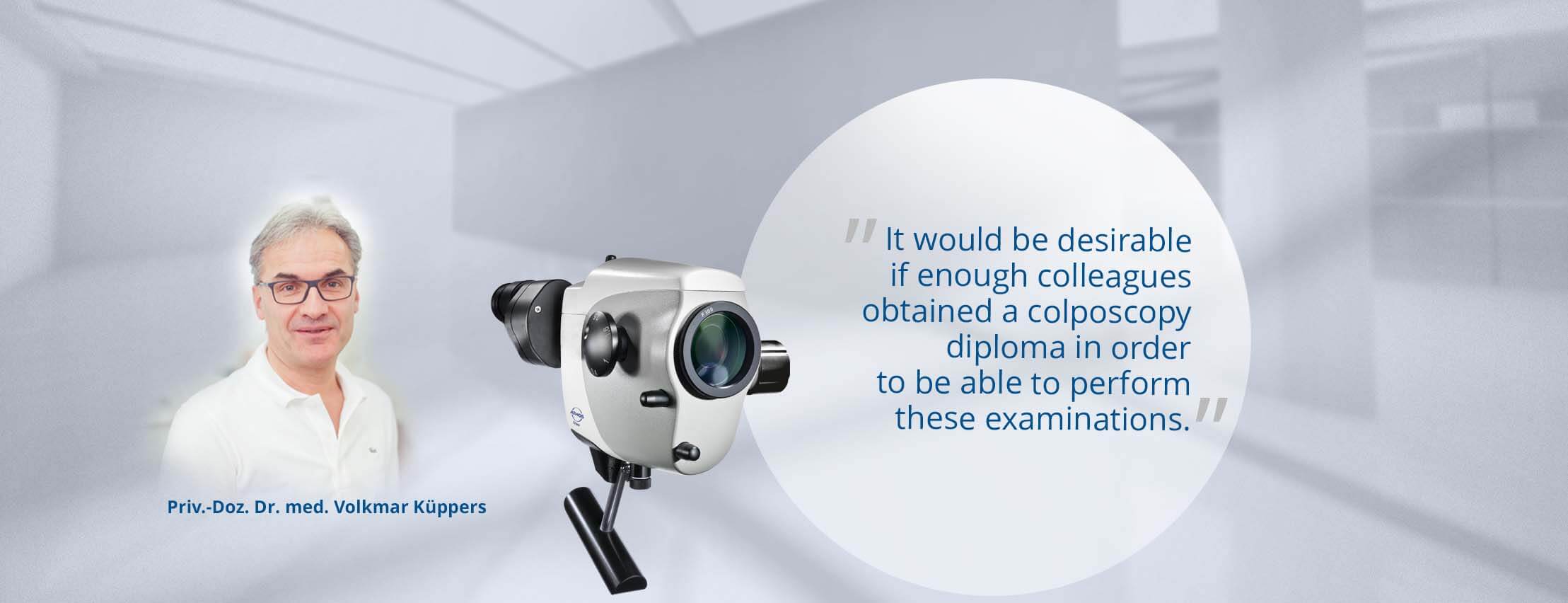
ATMOS i View COLPO
ATMOS colposcopes for dysplasia screening
The organized program for the early detection of cervical cancer began on January 1, 2020. For this purpose, the existing screening — in accordance with the requirements of the Cancer Screening and Registry Act — was redesigned in an organized program. For certain findings, the algorithm specifies that a colposcopic evaluation should be carried out, which has since then been reimbursable.
In early February, shortly after the program started, ATMOS spoke with Priv.-Doz. Dr. med. Volkmar Küppers.
Dr. Küppers, since the beginning of 2020, a new program for the early detection of cervical cancer has been in effect for dysplasia screening. What does this mean for colposcopic evaluations?
“If abnormal findings are detected during preventive care, women are now examined according to the algorithm from the early detection program. While women between the ages of 20 and 34 continue to receive an annual cytological smear test, women aged 35 and older are entitled to a so-called KO test, which consists of a cytological examination and an HPV test. For certain findings, the algorithms then provide for a colposcopic evaluation. Under this algorithm, colposcopy has been given importance that is also paid for, which I think is extremely useful.”
How important is colposcopy in dysplasia screening?
“Colposcopy is of central importance in the early detection of cervical cancer — if the preliminary findings are known, that is, the HPV findings and the cytological findings. Then, along with the biopsy, the pieces of the mosaic can be put together and a good therapeutic decision can be made.”
In the context of the early detection program, a quality assurance agreement for colposcopic evaluations exists that must be fulfilled by dysplasia screenings. How high are the requirements?
“Colposcopy should be quality-based, that is, it should be performed only by certified colleagues. The colposcopy diploma required for this is obtained after two courses, with a clinical practice phase in between, and an examination that is also very clinically oriented. In addition, specific numbers of patients must be proven regularly in order to demonstrate a certain amount of routine. Every year, the KBV (National Association of Statutory Health Insurance Physicians, Germany) therefore checks the previous year’s figures and only those colleagues who have reached these figures remain in the certification. At the same time, the KBV also recognizes the dysplasia screening and unit certified by the AGO (Working Group for Gynecological Oncology, Germany) and Onkozert.”
Is it difficult to reach the required number?
“No, because significantly more colposcopies will be performed than before. However, it is possible that not every individual practice will reach the number of cases required for certification. But given the high number of colposcopies expected to result from the algorithm, it would be desirable if enough colleagues obtained a colposcopy diploma in order to be able to perform these examinations. Among other things, there will be an increase because in 2021 all persistent HPV infections must also be evaluated. If we have to manage that with the dysplasia screenings that are certified as of early 2020, that’s going to be a big challenge. However, the number of certified screenings has been steadily increasing over the past few months. I think it’s right that colposcopy is now part of the evaluation.”
The quality assurance agreement not only prescribes the colposcopy diploma, but also formulates requirements for the equipment used during dysplasia screening.
“That is correct. There are quite big differences between colposcopes, for example between digital and analog devices, but also among video-colposcopes in terms of the quality of videos and still images. It was therefore fundamentally important, first of all, that requirements were laid down.”
The quality assurance agreement on the colposcope states, among other things, that “digital devices must at least correspond to the standard of analog devices in terms of image quality and resolution.” What do you think of analog devices?
“Seeing as I perform colposcopy-guided surgery on the cervix as part of my dysplasia screening, it is difficult for me to imagine giving up the three-dimensional view that looking through an analog colposcope allows. Also, the quality of the superb colposcopic images that are fit for textbooks can only be achieved using such an analog device.”
Are you experienced in using a colposcope with the H.A.S.I. filter?
“I’ve worked with it already. It helps before applying acetic acid to the cervix, when setting the image sharpness, and in evaluating vascular diagnostics. All colleagues will benefit from it, especially those who do not yet have quite so much routine in performing colposcopy.”
Contact
